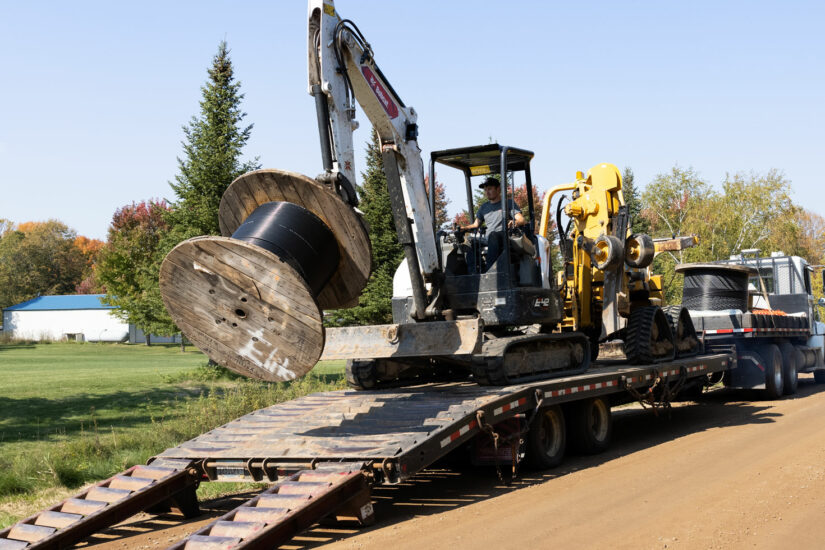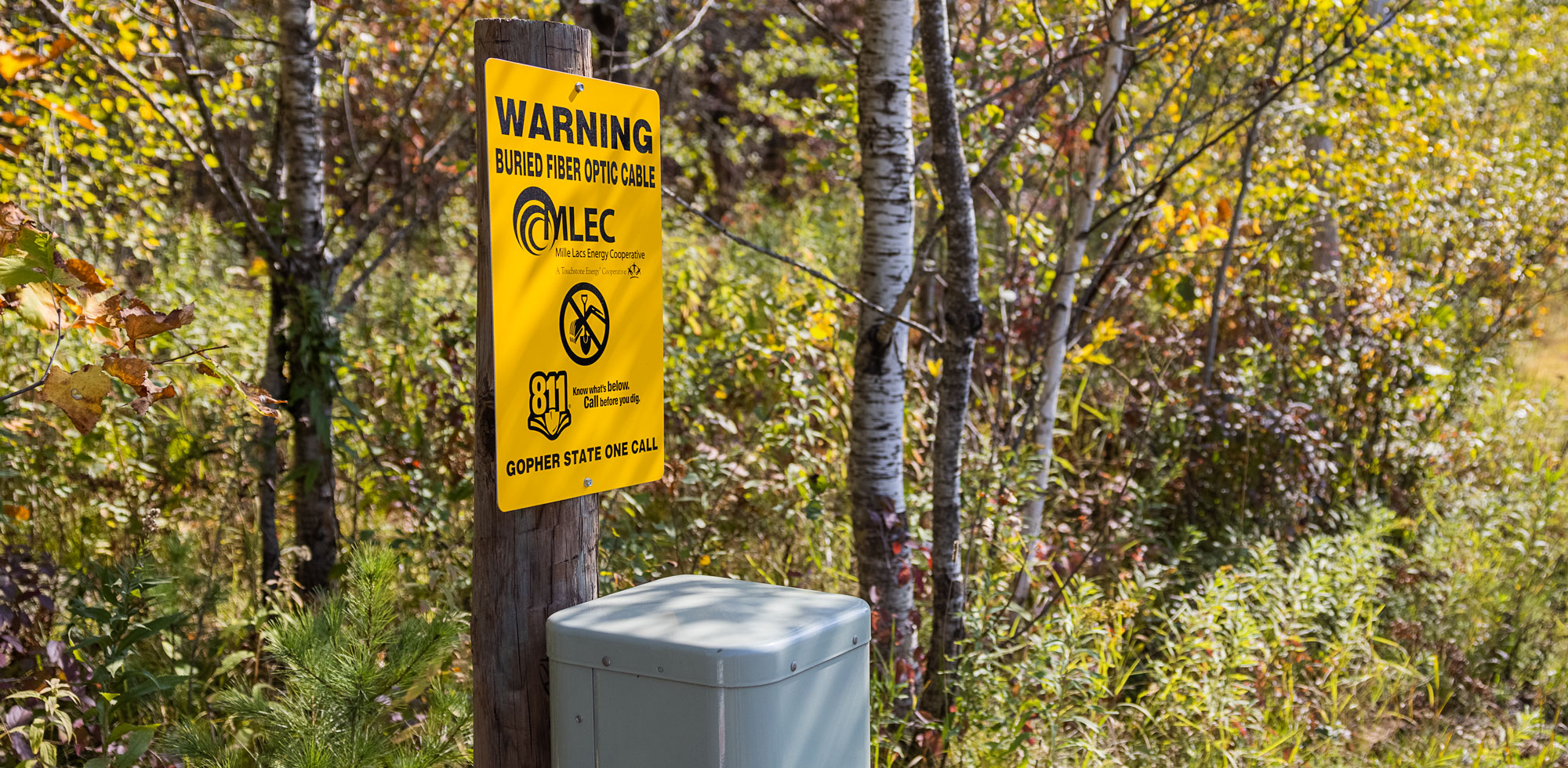
The Need for Speed
The pandemic proved it: Rural areas badly need broadband. So how can they get it?
By Gene Rebeck | Photography by John Linn
When the pandemic hit, Alise Sjostrom found out how crucial a strong and steady internet connection can be.
Sjostrom is co-owner and founder of Redhead Creamery, an artisanal cheese business she runs on her family’s dairy farm north of Brooten. Before 2020, she had sold much of her cheddar, brie and whiskey-washed munster to restaurants and through a distributor and specialty grocers, as well as her own on-farm store. The lockdown disrupted many of her wholesale sales channels.
In response, Redhead pushed its sales online, setting up door-to-door delivery service via e-commerce. “We used Facebook a lot with its advertising options,” Sjostrom said. “It worked for us.”
Just one problem: She’s had to fulfill those orders via an often sluggish internet connection.
“The internet drops, and then 10 minutes later you can do something or finish the task you were doing,” said Sjostrom, whose team experiences frequent interruptions. “It can be extremely frustrating to get work done. You can feel kind of paralyzed.”
Like most residents and business owners in the more rural parts of Minnesota, Sjostrom would like access to robust, high-speed broadband. Just over half of Minnesota’s rural communities have access to internet service that meets the state’s minimum standard—download speeds of 25 megabits per second (Mbps) and upload speeds of 3 Mbps. The statewide figure rises to 70 percent when the Twin Cities metropolitan area is included. During the past couple years—spurred by COVID-19—people who didn’t fully grasp the meaning of broadband now realize how essential it is to their personal well-being, and to that of their community.
But what about areas without broadband access? Experts advise: Get to work, or get left behind.
Why the Need for Speed?
Nearly everyone has internet connectivity of some kind. But what makes that connectivity truly beneficial is speed. This is where those megabits per second become critical.
“Why do we need broadband? Because people without it are not able to participate in society,” said Bernadine Joselyn, director of public policy and engagement for the Blandin Foundation. “It’s not just about gaming and Netflix,” she said. “It’s about opportunity.”
The pandemic sent that message loud and clear. People without a fast, reliable internet connection have found it harder to get jobs or take college classes. Businesses can experience lower sales. Houses without it are less likely to sell for a good price. And farmers need broadband to profit from all the data they can collect about their fields, such as the temperature and water content of their soil.
When it comes to connectivity, there are two kinds of speed—download and upload. Very simply, download is what you receive, and upload is what you send. During 2020, cloud computing platforms—Microsoft 365 with office applications, video conferencing solutions like Zoom and Microsoft Teams, and content-sharing solutions such as Box and Dropbox—became household names. And they all require robust upload/download speed. Residences and businesses with “a wicked upload speed can create value and earn income,” Joselyn said. In fact, broadband enables residences to become businesses.
“These days, if you have less than 25 megabits down and 3 up, it means you don’t have broadband,” said Bill Coleman, principal at Mahtomedi-based Community Technology Advisors, which specializes in helping communities organize and implement plans to improve broadband infrastructure. If you have only three megabits of upload speed, “one Zoom call will use all that, easily,” he said.
Where can a home or business get more megabits? Most communities have access to high-speed internet from their cable TV provider, though that’s typically available only in places with urban population densities. Fixed wireless is an option for residents in lower-density areas. However, it tends to work less well in hilly and/or forested areas, or for those living more than five to seven miles from a tower. A Digital Subscriber Line, or DSL, which uses existing phone lines, loses capacity the farther you are from the main distribution point. Many Minnesotans rely on cellular for their internet connection, though the quality of that connection also is highly dependent on location.
The option with the most capacity for speed is fiber-to-the-home, or FTTH. “If you have fiber to your home, it’s easy to get 1,000 megabits of service, up and down,” Coleman said. FTTH is also the most expensive option. That’s one of the reasons that he also noted that “in many ways, the gap between served and unserved is increasing.”
What’s more, if a community doesn’t already have broadband, Joselyn said, “it’s not going to get it unless residents figure it out for themselves.” In other words, underserved areas are likely to wait a long time for broadband service to come to them. They have to go out and get it.
Making Connections
Joselyn recommends that underserved communities band together to establish an advocacy team that’s willing to put in the work to engage and educate residents and to attract a provider.
To help communities get started, Blandin offers advocacy team leadership training, coaching, technical assistance and funding for feasibility studies and some broadband adoption projects. The local advocacy team develops the projects that will further the community’s technology goals, Joselyn said.
Broadband advocacy takes a variety of forms. The North Branch-based Chisago County Housing and Redevelopment Authority-Economic Development Authority (HRA-EDA) has been actively coordinating broadband development throughout the county, with the goal of getting broadband access for all residents and businesses. Several county townships have received grants from Minnesota’s Border-to-Border program, which provides support to unserved or underserved areas.

Nancy Hoffman, the HRA-EDA’s executive director, said most of northern Chisago County has been able to get FTTH through CenturyLink, and the county’s higher-density cities all tend to have good broadband. Development densities are lower in the county’s south and east, which makes it harder to attract providers. Low density is something that underserved areas have long struggled with—it’s why they’ve been underserved. “There just aren’t that many broadband providers looking to invest in rural areas,” Coleman said. For larger providers, low density means a low return on the investment. And smaller, willing providers don’t have the capital to cover the whole cost of installation.
Though broadband advocacy groups can tap a number funding sources, such as the Border-to-Border program, communities also need to chip in their own money, primarily through bonding or tax increases. That’s typically a touchy topic for residents. One way advocates can address it: Show how broadband will pay for itself.
Hoffman, for instance, lives in a township that received a state Border-to-Border grant. The township used bonding to make up the difference. Hoffman’s household will pay about $120 a year for 15 years to cover the cost. But she also was able to cancel her satellite TV, which saves her family about $100 per month.
“We really see [broadband] as an economic development tool,” Hoffman said. In a 2016 Chisago County survey, 31 percent of respondents said they would operate a home-based business if they had broadband access; 45 percent said they would use it for education. The right way to look at broadband, in other words, is not as an expense, but as an investment.
Getting the Money
Another useful strategy for community broadband advocates: Find a provider willing to be your partner. One such provider is CTC, a Brainerd-based telephone cooperative, which serves a wide area in Central Minnesota, reaching up into the Iron Range. Its FTTH networks provide speeds up to one gigabit (1,000 megabits) per second, both up and down.

CTC also helps communities and regions find additional financial support, said Kristi Westbrock, CEO and general manager and a member of the Initiative Foundation’s Board of Trustees. In the most rural parts of Minnesota, CTC aims for at least 80 percent in outside funding. Westbrock said CTC can “make a model work with 20 percent of our own capital.”
One big reason why rural FTTH installation is so expensive: driveways. “Some of those farmsteads have a half-mile driveway that costs $15,000 just to bring a drop-down along the edge,” Westbrock said. Still, CTC has completed projects in low-density areas that have raised funding from the U.S. Department of Agriculture’s Broadband ReConnect Fund, among other sources.
A particularly massive source is on its way with the passage of the federal Infrastructure Investment and Jobs Act. The infrastructure bill provides $65 billion in funding for broadband development in unserved and underserved areas.
What might this mean for underserved communities? “Get ready,” the Blandin Foundation’s Joselyn advised. Though $65 billion may seem to be a limitless font of funds, “there will be a lot of competition for the money,” she added.
That’s also true of all the kinds of broadband funding available for rural and other underserved areas. If your community doesn’t have an organization and a plan in place, Joselyn said, “you’re going to get left behind. And if you don’t have a plan, get help to get a plan.”